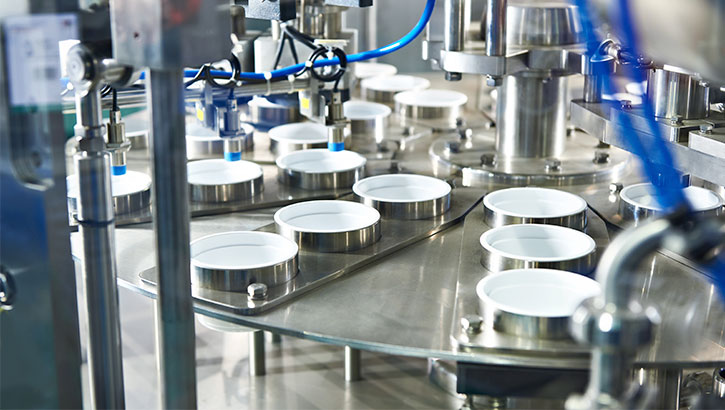Benefits and applications of the options available on the market.
The food industry relies on a wide variety of machinery designed to optimize every stage of the production process, from preparation to packaging. This comparison presents the main types of equipment available on the market, highlighting their benefits, applications, and how they contribute to improving efficiency, quality, and safety in food production.
1. Food processing machinery: mixers, cutters, peelers, fillers, cooking equipment.
Benefits:
- Efficiency and consistency: Ensures consistency in food preparation.
- Time savings: Allows processing of large volumes in less time compared to manual methods.
- Customization: Configurable for different recipes, textures, and product types.
- Durability: Made of stainless steel, corrosion-resistant and easy to clean.
Applications: Bakeries, meat processing plants, dairy products, vegetables, fruits and snacks.
2. Packaging machinery: sealing machines, filling machines, labeling machines, heat sealers.
Benefits:
- Extended shelf life: By hermetically sealing products, they protect against contaminants.
- Waste reduction: Precise packaging minimizes loss and improves utilization.
- Automation: Increases speed and accuracy in packaging.
- Attractive presentation: Improves product appearance for shelf display.
Applications: Packaging of liquids (juices, sauces), solid products (snacks, cereals), fresh or processed fruits and vegetables, and frozen foods.
Choosing the right machinery is as strategic as choosing the product you offer.
3. Inspection and quality control machinery: metal detectors, X-rays, artificial vision systems.
Benefits:
- Food safety: Detects foreign bodies or anomalies in products.
- Regulatory compliance: Helps meet international quality standards (ISO, HACCP).
- Prevents product recalls: Reduces contamination risks and protects brand reputation.
Applications: Processes where cross-contamination is critical, such as in meat, vegetable, or processed products.
4. Refrigeration and freezing equipment: cold rooms, freezing tunnels.
Benefits:
- Freshness preservation: Keeps perishable foods in optimal condition.
- Temperature control: Precise technology to preserve nutrients and quality.
- Energy savings: Modern models with low-consumption systems.
Applications: Fresh products, dairy products, meats, fish and vegetables.
5. Automation and robotics machinery: robotic arms, automatic conveyors, palletizing systems.
Benefits:
- Increased productivity: They accelerate repetitive processes such as assembly, packaging, and distribution.
- Error reduction: Precision in critical operations.
- Adaptability: They can be programmable for multiple functions according to the plant’s needs.
Applications: Large-scale production lines, such as in beverages and processed products.
Factors to consider when choosing machinery:
- Production volume: The machinery must be able to meet production requirements efficiently, without causing bottlenecks or unnecessary waste of time.
- Safety regulations: Ensure compliance with local and international regulations. Choosing machinery that meets these requirements reduces legal risks, ensures consumer safety, and facilitates health audits.
- Operating costs: Considering energy consumption and maintenance costs helps project long-term profitability of the investment. Operating costs can significantly reduce profit margins if not properly managed.
- Scalability: The ability to upgrade or adapt as the company grows. Scalability ensures you can respond to market growth without having to make major changes to infrastructure or production processes.
- Compatibility: Integration with existing machinery or automated systems. Compatibility with existing infrastructure avoids additional expenses and ensures a smooth transition to new machinery.
- Durability and Quality: Choosing high-quality, long-lasting machinery reduces the need for frequent repairs, improving efficiency and reducing long-term costs.
- Ease of Operation and Maintenance: Ease of operation and maintenance not only improves work efficiency but also reduces operating costs and the risk of unexpected production downtime.
- Supplier Support: Adequate support can reduce downtime and ensure your production continues to run smoothly.
- Sustainability and Environmental Responsibility: It is increasingly important for companies to commit to sustainability. Sustainable solutions are not only better for the environment but can also offer competitive advantages in the marketplace, especially if consumers value sustainability.
When choosing machinery for the food industry, it’s crucial to consider these factors to ensure the investment is profitable, efficient, and aligned with your company’s long-term goals. A well-informed choice can improve productivity, product quality, and market competitiveness.
Starting from specific specifications in each case, we carry out the design and comprehensive production of Complete Lines that cover the specific needs of each client. Tell us about your needs and we will carry out a personalized project that adapts to your requirements. If you wish, we can work together from the beginning of the activity, renew your equipment or adapt to your new needs. Together, we are stronger. Each Project is unique and personal. Our capacity and experience enable us to tackle any possible project within the Food sector.
